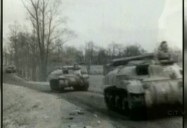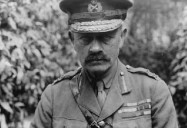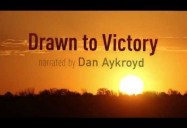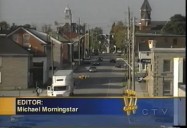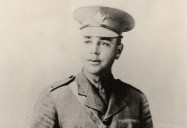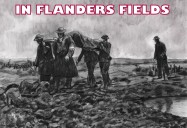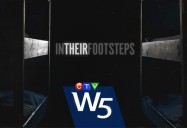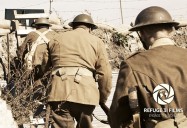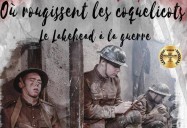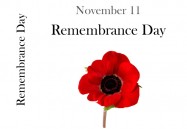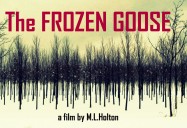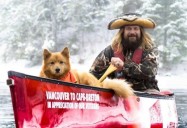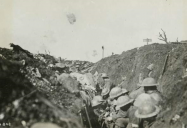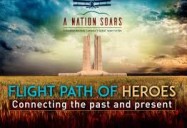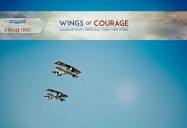
- Waterloo Catholic D S B Streaming Playlist
- WCDSB - After the Last River Playlist
- WCDSB - Remembrance Day Playlist
WCDSB - Remembrance Day Playlist
Vimy: Flight Path of Heroes: A Nation Soars Series
Width Height
Grade Level: 6 - 8, 9 - 12, Post Secondary
The past and present come together during a flying celebratory road show that spans two nations and two treasured anniversaries of nationhood. Vimy: Flight Path of Heroes adds to the visceral and visual impact of two significant dates in Canadian history - our 150th anniversary of nationhood and the 100th anniversary of the Battle of Vimy Ridge.
|
Running Time: 48:00 Country of Origin: Canada Captions: |
Producer: Sound Venture Copyright Date: 2016 Language: English |
Video Chapters
-
Vimy: Flight Path of Heroes: A Nation Soars Series 48:00
The past and present come together during a flying celebratory...
TRANSCRIPT
Close- [MUSIC PLAYING]
- [GUN FIRE]
- At 5:30 AM, April 9, 1917, on a bone-chilling and blustery Easter Monday, four Canadian divisions, united together for the first time, launched a meticulously planned offensive against the most impenetrable German stronghold on the Western Front, Vimy Ridge.
- Vimy Ridge in that part of France rises approximately 145 meters above the surrounding territory. So what that meant is whoever held Vimy Ridge could look down on whatever the enemy was doing. That made it a strategic position of utmost importance.
- Vimy Ridge was the graveyard of armies. There had been at least 300,000 French and German soldiers killed or wounded there in seesaw battles back and forth. And in fact, very few people fought the Canadian Corps could actually take the ridge. Sir Douglas Haig, the British commander-in-chief, tried to warn off Henry Horne, the 1st Army commander, that maybe he should attack further south of the ridge. But Third British Army further to the south said no, the ridge has to be captured or the entire offensive will have no chance of success. So the Canadians were given that very difficult position and they had about three months to prepare for that battle.
- The war, if you look at it through its various phases, you can see an evolution in war fighting. And the Canadian Corps, which by late 1916 was 100,000 strong, commanded by Sir Julian Byng, a British general, is always learning. They were adding in new weapon systems. The tank is introduced in September of 1916. The integration of air power to assist the gunners on the ground, all of this is coming together.
- Combat on the Western Front was very much a matter of learning how to deal with the technology of the day. A prime example, if you will, in the First World War is the introduction of aerial photography. Aerial photography would be a game changer not only for planning battles but also to working with the artillery. So that by 1917 when the Canadian Corps assault Vimy Ridge, literally tens of thousands of photographs would be taken of the front lines in order to make sure that the Canadians were as well trained and as well prepared for the assault.
- The heroic and extraordinary efforts by Allied pilots in the air prior to the battle and during greatly contributed to Canada's overwhelming victory on the ground. Canada's magnificent Vimy Memorial marks the site of the battle of Vimy Ridge and proudly stands as a tribute to all Canadians who bravely fought and died in the First World War.
- Today, thousands of miles from the shore of Canada, we are assembled around that morning.
- On July 26, 1936, King Edward the VIII officially opened Canada's memorial.
- It was over there where the Canadian Army fought and died. It is over there that their final monument will stand.
- The memorial was erected on the ridge's highest vantage point, hill 145. Its prominent towers, representing Canada and France, watch over the hallowed ground like two stoic sentinels.
- For this glorious monument, [INAUDIBLE] the hill of Vimy, is now and for all time a part of Canada.
- One of the highlights of the moving and reverent opening ceremonies back in 1936 occurred when squadrons from the Royal Air Force and French Air Force flew past the monument and dipped their wings in salute. As the commemorative 100th anniversary of the Battle of Vimy Ridge approaches on April 9, 2017, a small squadron of pilots known as Vimy Flight would fly replica First World War biplanes out of British Columbia, have long dreamed of recreating the Vimy formation fly past performed by their predecessors of long ago.
- It is a tribute to what they did and what they accomplished in the First World War. And out of recognition to them and their untold story, we formed a little flying team. And then the bright idea was, well, Vimy Ridge is coming up. Can we take them to Vimy Ridge?
- We have an air abort, then the element will look after--
- The ambitious idea of creating Vimy Flight came to lead pilot Allan Snowie in 2009. Allan, an aviation historian and former Royal Canadian Navy and Air Canada Airbus pilot, had always envisioned bringing together a team of retired and active Canadian military pilots to recognize the sacrifice of First World War Canadian soldiers and airmen.
- Allan Snowie approached me eight years ago with it, and straight away I knew that's what I wanted to be involved in. So Allan and I acquired Nieuports, and then laterally acquired pilots to fly Nieuports.
- I ran into Peter Thornton who I'd flown with in the Air Force. He was my ops-O on my squadron. And the first phrase that he said is, "We're going to be doing something special. Are you interested?" I knew there would be a lot of work up and there would be a lot of personal sacrifice. But it is a very good cause and I was very honored to be a part of it.
- When I heard about Vimy Flight and what they were doing to commemorate the Battle of Vimy Ridge, I knew I had to be part of it. I have a great respect for that generation that manned up and came forward. These were our earliest pioneers of aviation.
- In the climb out, we're going to break away into element.
- The team evolved over time. And it was recognized that some of the pilots had working jobs flying for Air Canada or other positions. We wanted back up, so we started to expand the team.
- Yep, for this, we're going to have five aircraft in the air.
- We wanted all ex-RCAF pilots because we all come from the same place. We all know the hand signals. We know the formation structure. We know how to do it. And most importantly, we know what the other guy's thinking when we're up there.
- [MAN ON RADIO]
- Yesterday was my first flight in an open cockpit. And after I was finished chewing up all the bugs, it was absolutely amazing.
- I've always wanted to fly since I could talk. And my mother always joked the first word out of my mouth was airplane. I was one of the few pilots in the military to fly for practically 16 years straight.
- OK, so we will do is our right-hand orbit here.
- A lot of the different missions and roles we did included formation flying. Especially in the fighter world, that's your bread and butter. We always fly in groups. There's safety in numbers.
- The youngest member of the team, Captain Brent Handy, is a Royal Canadian Air Force F-18 fighter pilot. He also serves as a check pilot and instructor with Canada's aerobatic formation team the Snowbirds.
- Incredibly, now I get the opportunity to fly hundred-year-old designs with these Nieuport replicas. They're not as refined on the flight controls as you'd expect, but they're a heck of a lot of fun. And as someone who loves to just fly airplanes, it's a hoot. It's perfect. Being that they're open cockpit, hair blowing in the wind-- I guess that's not exactly the case for me. But yeah, it's a really cool, organic experience. And I just, I can't get enough of it. It's awesome.
- I'm a former naval officer. What they teach you in the navy are three things-- know your ship, know your men, know yourself. Knowing myself at this stage, my strengths and weaknesses, I wanted a solid team. The fellows we picked are pretty darn rock solid.
- The last point, know your ship. These are lovely little ships. And we're all very proud of them. And these chaps fly them very well.
- One of the greatest challenges facing Vimy Flight is how to transport their aircraft to France. Flying them over is not an option. Or is it? With the main event only weeks away, the Royal Canadian Air Force steps up.
- I've been in the military 37 years, and this is definitely unique, one of the most challenging things that I've done so far. The unit I belong to is out of 8 Wing Trenton. My role there is basically to take equipment that is not every day carried on aircraft and figure out the best plan to load it up, get it from point A to point B.
- So most of the things that we load are using heavy equipment like armored cars, tanks, huge things that really you don't have to take too much care when you're tying them down. You can use chains on them. This is definitely outside the box. And we had to develop a different approach as to how we get these on and what we're going to do with them when we get them on the aircraft.
- Mixed emotions. This is happening, my goodness. You know, when that thing landed and rolled up, right away you know, we're going to France.
- So the day of loading the aircraft to leave Canada was one of great significance for us because we have been working so hard on this project.
- We're wearing kid gloves and we're very, very careful. These things are very fragile. They're fabric. They're basically in a flying condition right now, so we can't damage them. So it was quite the operation getting them on board.
- Two feet, two feet, keep coming. Done.
- There's in some places five inches separation between our craft. So very dynamic, very dicey, and obviously the owners of the aircraft were very concerned and worried that things could go sideways.
- Now I know what the word professional loadmaster means. Look what they've done here. They've got them all fitted. And they've got all the aircraft in and all the wing parts-- the luggage, the toolboxes. There's more than enough space. Wow.
- Roger that. We're cleared for takeoff. Terminal airborne, I have a transition to a roller.
- Pressure.
- My head's up.
- The symbolism is amazing. And these folks strap themselves in behind a fuel tank and went into enemy fire with basically a helmet and a pair of goggles on. Now we're inside this enormous aircraft with state of the art avionics and 40,000 pound thrust engines. The belly of this aircraft holds seven of these things, which probably represents half a squadron back in the day.
- After two days of air travel across Canada and the Atlantic, the C-177 Globemaster and its precious cargo arrives in Lens, France to a hero's welcome.
- Right from the very start there was a massive amount of French people there, volunteers ready to help. Everybody turned out. And we've just found the whole experience has been humbling because the French cannot do enough for us.
- You can tell that the French have been brought up with this history because it's obviously in the back door. As soon as they know you're a Canadian, they can't do enough for you. It's wonderful.
- While it's really heart touching to see all the Canadian flags around the villages-- so just about every house has a Canadian flag on it.
- There's more Canadian flags than there are French flags. And you see the amount of gratitude and appreciation that people have for what our veterans did for us. And it definitely drives home the pride that we should all have as Canadians. And as a military officer as well, I mean, it makes me very, very proud.
- The Canadian flags all came from Fredericton, New Brunswick I heard. So they're hanging them out of respect, out of pride, out of honor, out of pure happiness to have us here.
- Here at the Lens airfield it's been really amazing. There's been so many people that have come out. People just walk up to the aircraft. They want to get their picture taken. We put the helmets on the children. We're just having a lot of fun. Everyone's interested. Everyone wants to know.
- We're very lucky in that we have a grass airstrip to operate off because that makes it much easier on our airplanes. And that's exactly the type of airstrip that the young men would have been using back in 1917.
- What's really crazy about this, especially on a Saturday like today, is that everybody comes out. We've got spectators walking around. You can hear gyrocopters. You can see parachutists. There's flying clubs training. It's challenging.
- To ensure that everything will go like clockwork with their Vimy Memorial Formation fly past on April 9, the Vimy Flight team performs numerous practice runs. Each is executed with military precision and a clear focus on the ultimate mission ahead.
- The principles of formation flying are the same-- anticipation, power management, situational awareness, how you handle the controls. The big difference is these airplanes have no hydraulic support. It's all stick and rudder. It's all cables. And they're very light airplanes. So you are getting tossed around. You're doing your best to maintain the formation. But the principles that we learned on the Snowbirds are very similar.
- So how it works basically, because we have 10 pilots, we have five airplanes flying. We've decided to have one pilot act as a safety pilot to make sure that all of the checks are done properly. And it's also, as you see, a very small cockpit. So we're helping them strap in. We're double checking his radio, making sure that everything is set for his flight.
- So Gordo, your first flight out of here is going to be a familiarization flight and just a recurrent flight on the Nieuport.
- I did not have a lot of taildragger time, as these are known as type of aircraft. So for me it was a whole new experience in many, many ways. It's been exciting to learn how to do something different again.
- These are the aircraft that our grandfathers flew. And in order for these individuals to be successful on the aircraft and to work as a team, they have to almost back up and visualize themselves as knowing absolutely nothing and become that student that is like a sponge, a young student who has no background, put all their tools away, and listen very carefully to what skills are required for this job. Once they learn that, then they can start to piggy back their old experience back on top of the present ones that they're newly developing at this time. These aircraft, although they look fairly harmless, they do require a certain amount of discipline and skill to fly in close formation.
- The maneuverability of these aircraft is not the same as when we were flying T-33s or Tutors or whatever it is. These aircraft, there's some trickiness to them, especially when the wind comes up. And we are flying quite close.
- I had the privilege of flying the first flight over Vimy Ridge. And I'm glad I did it solo because when you've been involved in something for so many years, all of a sudden it's right there. I have to admit my goggles did steam up a little bit as I went by.
- You fly by Vimy Ridge and you fly by the graveyards and you can feel all of the brave Canadian men that have lost their lives and paid the ultimate price.
- I had tears in my eyes going over for the first time. I've seen Vimy from the ground and the cemeteries, but to see them from the air-- I mean, it was a whole generation lost and they really gave a lot.
- Every single one of our guys has come back off that first flight and just been totally carried away by what's just gone on emotionally. You can tell they're very, very affected emotionally by it, including myself.
- Yeah, I don't see this as an air show in any way. I see this as the chance to connect with my roots as a military officer. This was the very first fighter pilots that ever existed. So to be able to share the skies with where they once flew, it's mind boggling for me. I look down and I see, when you fly over Vimy Ridge, you can still see the pock marks where the artillery was. And you can still see some of the preserved trenches. And despite having been educated about the subject, I still have a hard time just imagining how it could have been back then.
- On the 4th of April, the Royal Flying Corps launched a massive aerial offensive against the German Air Force. And sophisticated, competent, efficient killers such as the Red Baron, Manfred von Richthofen, took a terrible toll of the Royal Flying Corps, both of their fighter units and of their army cooperation units. The Royal Flying Corps called April, 1917 bloody April because of the casualties that they experienced. They would lose almost 400 airmen either killed, captured, or wounded. At the same time, they would keep feeding into that slaughterhouse young, impressionable aircrew pilots with a minimum of training. Even though they managed to maintain air supremacy or air control over the battlefield, they did so at a horrible cost. One of the few Allied fighter aircraft that could handle the latest German scouts were the French Nieuports.
- The Nieuport is a dynamic little machine. It was originally built before World War I. Air events would have pylon racing. And the Nieuport manufacturers were looking for something that they could race around the pylons faster than their competitor. The Nieuport in World War I was recognized as being an agile little machine, and it could work very well.
- The French Nieuports were a versatile, lightweight, nimble fighter, but they were undergunned.
- As early as 1915, the Germans had shot down their first Allied aircraft using a nose-mounted, synchronized machine gun capable of firing through their aircraft's propeller. In contrast, the British were struggling to develop their own synchronized machine gun, and the wing-mounted Lewis remained the weapon of choice for Nieuports.
- The gun would be on a mount that would actually allow the gun to be pulled down to the pilot. Then the pilot would have to release the magazine, grab another one, stick it on, and arm the gun, cock it, and send it back up on top of the wing. So all that while flying.
- For one soon to be famous Canadian aviator, the limitations of a Lewis machine gun did not appear to affect the number of victories he would accumulate. William Avery "Billy" Bishop claimed his first victory in the skies over Vimy on March 25, 1917, and would eventually become the war's third greatest ace with 72 victories.
- Billy Bishop was serving in Number 60 Squadron, Royal Flying Corps during the Battle of Vimy Ridge. He came into his own during this time period as a hunter. He gave no quarter to the enemy. He was not the best flier in the world but he was a heck of a shot. And what that meant was he would maneuver his aircraft to a position where he could kill the German pilot. And by this, he started to make a name for himself during April, 1917.
- In 1917 he was just 23 years old. So he was somebody who was really in the prime of his early adulthood. And he was an adventurer and explorer. And that contributed a lot to why I think he pushed himself so hard.
- He would often go out on his own, even after he'd done a couple of missions a day. He could do up to four patrols a day. He would take risks and go out very early in the morning when it was still dark. He really had a sense that he wanted to improve his score, but I think he felt he had a sense of mission.
- On April the 8th, he became an ace and had shot down five planes. So for him, it was a great month. But on the other hand he was losing friends left, right, and center, and so was the war effort. Because if you look at bloody April alone, his squadron, 60 Squadron, lost about 18 people, and the Fourth and Third Squadron was about 19. So he lost most of the people he knew.
- Well what we have here is the windscreen of Billy Bishop's Nieuport 17 when he was with 60 Squadron, Royal Flying Corps. On April 8, Bishop was fired on from behind and clipped the side of his flying helmet and smashed through the windscreen of his Nieuport 17. And he mentioned that it was one of the closest calls of his flying career.
- I think that's the greatest mystery about my grandfather is, how did he survive? Because not only did he do one full mission in 1917 but he went back in 1918. So the actual survival rate for a First World War fighter pilot was about 10 days. And when you think of two tours over a couple of years, it's mind boggling. So was it destiny? Was it something that was just sheer coincidence and luck? Who knows. But I believe that he had a mission in life and a purpose in life, and he lived up to it.
- The first day of the battle, the 9th, when most of the ridge was captured, about 7,700 casualties. It was an absolute bloodbath. It was hand-to-hand combat. They were advancing until they ran up against a solid wall of machine gun fire. And all of that cost lives.
- Most of the infantry battalions that fought at Vimy went in with about 600 or 700 soldiers. And almost all of them suffered between 200 to 300 casualties. So that gives you a sense of the barbarity and courage that it took to capture this ridge.
- Your second day here, before we get into all the work, I did want you to be here in the monument and see what it looks like because it's pretty heart rendering.
- After the war, one of the things the Canadian government did was decide to erect monuments overseas to mark the great Canadian battles. And they decided to mark eight of them. They ran a competition in Canada in 1920 and Toronto architect and sculptor Walter Allward won.
- What's interesting is that his monument was not initially to be on Vimy Ridge. They hadn't yet decided where to put it. But when the Canadian government decided to build the monument on the ridge, that then elevated Vimy. It took Walter Allward 15 years to build that monument. And when it was unveiled in July 1936 in front of 6,000 Canadian veterans who crossed the Atlantic, that then propelled the Vimy idea forward. Vimy became something more than a battle.
- France ceded this land to Canada in perpetuity. And here we stand on Canadian soil.
- Early morning walks, that's the most spiritual time for me. It's the most evocative. And the landscape is beautiful. The sun is just coming up. And the shadows are lighted so dramatic. It's the best time for me to visit these cemeteries and just pay my homage to these young men that paid so much for our freedom.
- The little cemetery in the village where we're staying is probably one of the minor cemeteries around here. We tend to think of British as meaning United Kingdom. In those days it meant British Empire. So we find soldiers in there from South Africa. We found some from Australia. There's Canadians in there.
- And you can tell a lot by looking at their rank, by what regiment they were with, how old they were. This is the gravestone of Captain Knight. You can see his date of death was 20th of December, 1916. Distinguished Service Order, Military Cross, Royal Flying Corps-- he was one of Canada's first aces. And he was the Red Baron's 17th kill. Here's five in a row, Royal Flying Corps, all the young fellows, second lieutenants.
- The other thing that impresses me is this is after a hundred years and these grave sites are manicured to perfection. And there are thousands of sites like this all over Northern France and Belgium.
- The care and upkeep of these pristine sites is the cherished responsibility of the Commonwealth War Graves Commission. So the Commonwealth War Graves Commission cares for cemeteries and memorials in 23,000 different locations in 154 different countries all around the world. And there are Canadians commemorated all over, from the Far East through to the UK and of course here on the Western Front in France and in Flanders.
- So this is the commission's headquarters near Arras in France, not far from Vimy Ridge. This is where we make the headstones for all of our cemeteries all across the world, where men and women who served with British and Empire forces in the two world wars are commemorated. Many of them, of course, are Canadians. So the headstones for their graves are made here and shipped all over the world.
- Well the commission was first established during the First World War in 1917, not long after the Battle of Vimy Ridge. And it was a collaboration between different nations, between the UK but also Canada, Australia, New Zealand, South Africa, and India. All of those countries are represented on the commission today. They're the six member governments.
- So during the First World War, what was then called the Imperial War Graves Commission brought together some of the greatest artists and architects of the time to design how the war cemeteries would look and how the soldiers would be commemorated. They came up with the idea of having the same headstone for all of those who served, regardless of their rank. On each headstone you'll see a regimental symbol and the name of the soldier. So for every Canadian solder, that means a maple leaf inscribed on that gravestone.
- Originally that would have been carved by hand, would have been a hugely laborious task, a really skillful task for the stonemasons of the time. But of course now we use machines to inscribe the headstones. It's much quicker. And we produce thousands of headstones here in Arras every year.
- Our motto, which was invented in the First World War, is their name liveth forevermore. That was the phrase that the great poet Rudyard Kipling came up with. The idea from the First World War was that soldiers who had fought together, served together, and died together should remain together where they fell. That was the decision that was taken at the time.
- And it was a difficult one for families. It wasn't without controversy. Many of the families wanted to bring their loved ones home. But I think there was a general feeling that this was the right thing to do. This is what the soldiers would have wanted themselves. And what it means is that the Commonwealth War Grave Commission's cemeteries are almost a map of where the fighting took place. And today those places are an incredibly powerful reminder of all of those who served and fell fighting for Britain, but also for the Commonwealth in the two world wars.
- The ground beneath Vimy provided more than just a final resting spot for the war dead. Lying deep below its surface is a haunting subterranean world that served many military purposes.
- Well, we've obviously had a lot of experience up in the air. Now we're going to go below the surface and see what the soldiers were experiencing in the tunnels below.
- My granddad fought here and my regiment was there, a Canadian Scottish regiment, Princess Mary's. And there's a piece of art that I've seen pictures of that I'm hoping to see today.
- To think of anything between 150 to 200 men are living down here. Along the walls there are bunks, anything up to four high. The only lighting is candles. There's three things that I look around and don't see. There's no pornography. There's no condemnation of the higher command. And there's no anti-German sentiment.
- It's crazy if you think that guys are living down here for a long period of time and they're sending a message. This might be the only message that they got to send home, and here it is. It's like it's frozen in time. HD Schofield, from Blackville, New Brunswick, from where you guys are from.
- Yeah.
- That's our province.
- Wow. We're from Moncton.
- That's 16th Battalion, Canadian-Scottish.
- Yeah.
- Yeah, there's [INAUDIBLE].
- Right next door to the 96th. That's what I was looking for right there.
- You know, we're supposed to bring Vimy home. And this tour has actually given us something to really share with other Canadians about how those troops lived below ground, an amazing experience.
- This is really stirring for me because what it brought it home for me walking down there I found carved into the walls a regiment from my hometown in Saskatchewan. And it brought tears to my eyes once again, these poor boys waiting to go into battle.
- The bravest men of the First World War were the ones in the trenches. They go to bed in a mud hole and we aviators go to bed in a reasonable bunkhouse. Humbling.
- It was incredible. That was hallowed ground for my regiment. And to see all those carvings, I'll tell you, I'm just tingling all over. It's such a piece of history to be able to see that and feel the surrounding. And today it was a nice day down there. There's no rain. There's no smoke. There's no artillery going off overhead. It's just a chance to appreciate and see history. I'm just overwhelmed.
- They were just guys, just regular people, kids from our communities that were put in a situation like that. And they left their mark down there and they left their mark for Canada.
- This is game day. Show's on. But a hundred years ago on this day in 1917, it was a snowstorm. There was sleet. There was snow. There was high winds. And young pilots, those 17, 18, 19-year-old kids get in those airplanes and go. They didn't have a choice.
- Well today we have 23 degrees Celsius for the high, beautiful blue sky, bright sunshine. You could not get better conditions to go flying. And we're really excited about it. We've done three practices so far.
- We did our last practice yesterday. It was fantastic, went very smooth. We had one small incident when we came back.
- The harder-than-usual landing by lead pilot Allan Snowie results in a broken axle and a trip to the hangar.
- Yesterday was not the time to make an aircraft carrier landing, but I did. Kind of busted my ego in a bit. Now pilots need that every now and again. But they were here up to 11 o'clock at night when we shooed everybody home to get some sleep. They were back in action 7:30, 8:00 this morning.
- We've got four hours left. And we're just starting to stick it back together. So we still have to finish the welding and we have to come back here, we have to fit it. And we have to reassemble the airplane. So we've got stuff to do.
- [BANGING]
- It goes almost back to the First World War. The intensity of the action was so great that you flew, you came home, you went to bed. You get up, you flew. And it was the late night and the overnight workings of the ground crew, they are the unsung heroes in a lot of ways of World War I squadrons. They'd worked through the night. They'd make sure the aircraft was ready for the next day because that was their pilot. And the fitter and the rigger of each aircraft wanted to make sure that their pilot came home again that next night.
- This is truly something. Is not just small airplanes flying in the sky together. It's something that we're trying to represent and try to honor and commemorate the loss of those airmen before us. And it's something that-- well, it's basically in our hearts and souls.
- With numerous high-profile international dignitaries at the commemoration ceremonies and with so many visitors from France, Canada, and Britain attending, security is heightened on the ground and in the air. It is the responsibility of the French Air Force to provide an escort for Vimy Flight and safeguard the skies overhead.
- We are here to intercept any aircraft will be interfering with your flights this afternoon.
- This is the 11th hour. Quarter to 2:00, we brief in 55 minutes.
- So this little guy came from Cold Lake, Alberta. It was giving him my son for his first birthday from Santa Claus at the Cold Lake officer's mess. And he's been a pretty loyal traveler of my sons. And he sends them off with me on any kind of notable mission. So he's flown with me in the F-18 over the Arctic. He's flown with me in the Snowboard jet. And now he's going to fly with me over celebrations of our victory at Vimy Ridge. We've got to make sure he's strapped in tight.
- OK, this one is safe.
- Wheel is on.
- Our friends from Belgium are just helping us with support wires, and we're done. Next we roll it out and we let the pilots do their walk around, check the oil, the fuel, and we get prepared to launch.
- So we'll do a taxi test now, confirm everything.
- [AIRCRAFT ENGINE]
- We're good to go.
- Welcome Vimy Flight. This is our big day.
- For the pilots of Vimy Flight, there's one final briefing before they enter their cockpits and take to the air as those courageous pilots did more than 100 years ago.
- --longer taxiway. I can tell you now that the field elevation down there is 150 feet. But to try and keep in standard, just dial up your altimeter to 170 on the deck.
- Flying always involves risk. And we're really in the business of risk management. I believe that 10 of us have a combined total of 230,000 flying hours. And with that sort of flying experience, we understand all the aspects of risk management. And we do everything we can to minimize that. And at the end of the day we still have to get up there and do the job.
- This is the big show. And in fact if anybody says they're not anxious or they're not nervous, I'll be worried about them.
- Preflight preparation is very similar to what we do in the Snowbirds and in the Canadian forces in general. We brief the plan. We go fly. And then we come down and then we debrief the plan.
- Even though these guys have been out of the game for maybe 10, 20 years plus, as far as military flying is concerned, we're all still definitely on the same page. It seems like another day at work for me in a lot of ways.
- [AIRCRAFT ENGINE]
- This is, in a way, the culmination of a great career that I've had. It's the most interesting project I've ever done. And it will be one of the crowning pieces in my career.
- 7,004 Canadians were wounded in the battle that began here 100 years ago today. 3,598 Canadians died. 100 years later, let us hold to the grace of the ones who stood by their friends through unimaginable hardship and who stood by their country. They were Canadians, and they were valiant beyond measure. Honor them.
- I came to Canada with a very young family. I have had a wonderful life in Canada. And so too have my children. And it's all because of these young men here and the veterans and the serving members of the Canadian Armed Forces that have protected this democracy that we have and this wonderful freedom. And this is my way of saying thank you to them for that.
- Please turn your attention upward as we welcome the Vimy Flight from Canada as they fly past the Canadian National Vimy Memorial.
- Fantastic day.
- How do you feel, Dan?
- Pretty good. Pretty good day in history. We're really proud to be Canadians today. It was amazing to look down and see the thousands and thousands of red and white jackets and shirts. Yeah, it was a real pleasure to be up there today.
- How you doing my man?
- Good, how are you?
- Excellent, fantastic.
- That was great. Oh man, it just feels really good.
- Hey Larry.
- Nice job lead.
- Thank you very much.
- Nice job.
- Real pleasure working with you guys.
- Yeah, it was perfect. A lot of patriotic, red-shirted Canadians out there today. It was awesome. You can't get a better day for flying than that and no better reason to go flying for sure.
- I hope Canada gains from this. This is our year to wave the flag high and mighty. And what you're seeing here in France now is a dream come true for all of us.
- - --for hanging on.
- We appreciate it.
- How'd it feel?
- Fantastic. Best flight of my life. I don't know what else to say. It's emotional, man. It's a very, very emotional moment. We just had a wonderful flight. The air was smooth as glass. Everything was set up for us to win. And we did.
- Through meticulous planning, everything was set up for the Canadian divisions to win the battle of Vimy Ridge. And they did with near-flawless execution. It was a historic achievement for a young nation that would face many more hard battles ahead.
- When the first shots of the First World War were fired in 1914, aviation was still in its infancy, unstable and death defying. But this only added to the adventure for the more than 22,000 young Canadians who ultimately served in the British Flying Services. Many flew the crucial reconnaissance missions, while others were the knights of the skies protecting them. For Canadians back home, they were all heroes at a time when our nation soared.
- [MUSIC PLAYING]
TRANSCRIPTS:
Interactive Transcript
Transcript (PDF)
